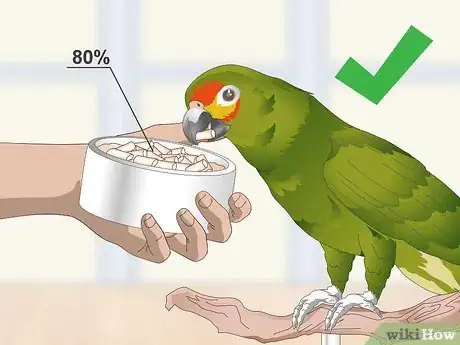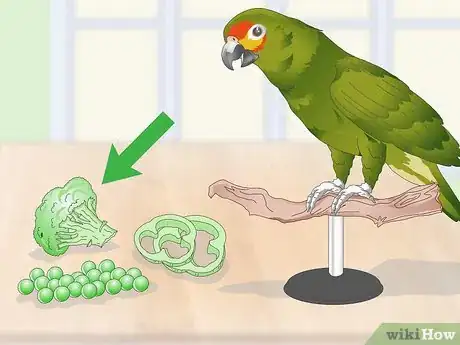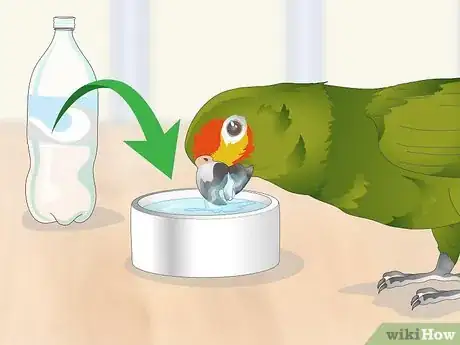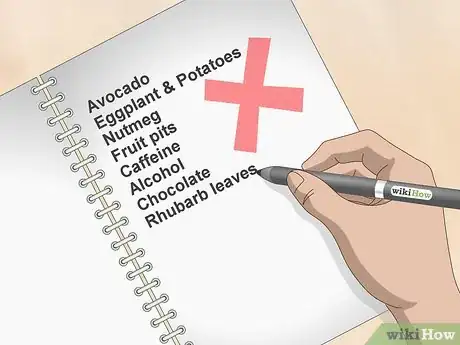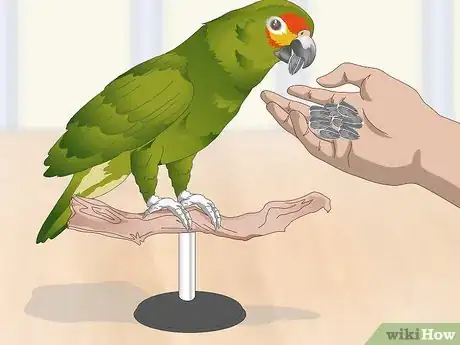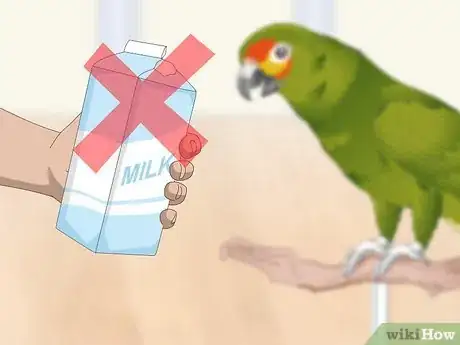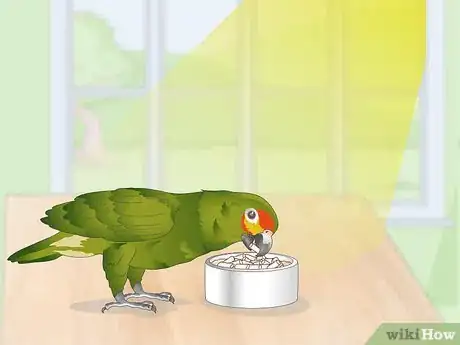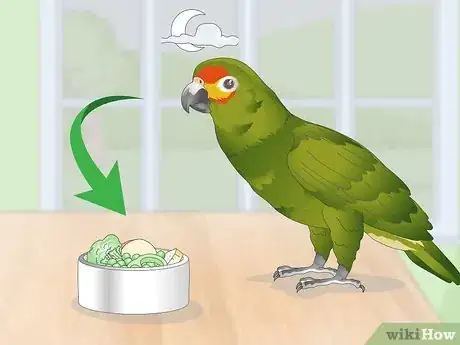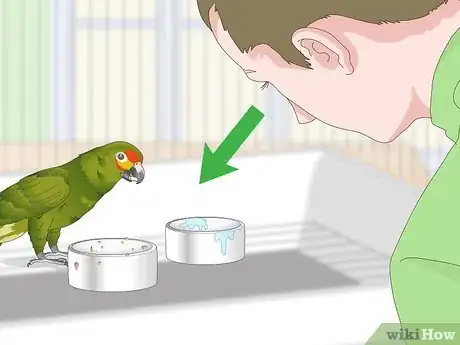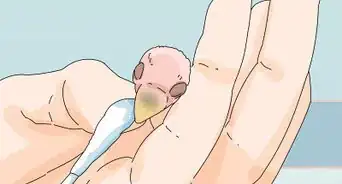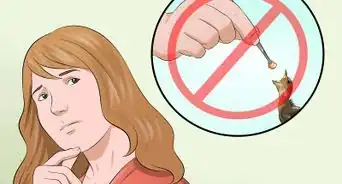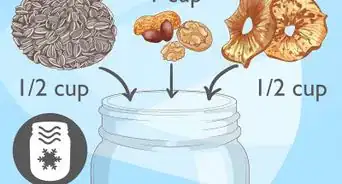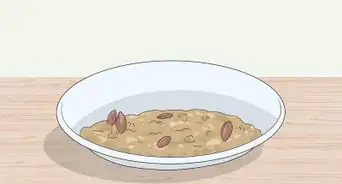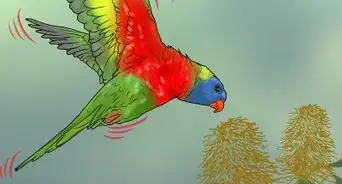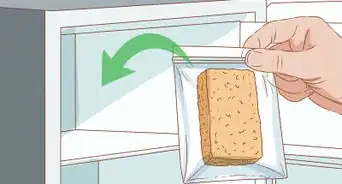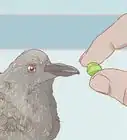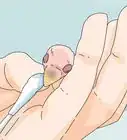This article was co-authored by Pippa Elliott, MRCVS. Dr. Elliott, BVMS, MRCVS is a veterinarian with over 30 years of experience in veterinary surgery and companion animal practice. She graduated from the University of Glasgow in 1987 with a degree in veterinary medicine and surgery. She has worked at the same animal clinic in her hometown for over 20 years.
This article has been viewed 17,891 times.
Keep your Amazon parrot happy and healthy by feeding it nutritious foods. It is ideal to give your parrot a pellet diet, which will cover most of the nutrients it requires. You can supplement pellet food with fresh fruits and vegetables. Avoid foods that may be harmful to your bird, and make sure it always has fresh water.
Steps
Providing Your Bird With a Balanced Diet
-
1Feed your Amazon parrot food pellets. The best diet for your Amazon parrot will consist of about 80% food pellets, which are developed to be nutritionally complete. Pellet food provides all of the nutrients that you pet parrot needs at different stages of its life, and can be bought in different colors and flavors. Purchase food pellets at pet stores or online.[1]
- Food pellets should be readily available and replaced daily.
- If your parrot is overweight, consult your veterinarian and limit its food accordingly.
-
2Supplement food pellets with fruits and vegetables. Your Amazon parrot will enjoy fruits and vegetables in addition to its pelleted diet. Fresh produce is ideal, and it can be fed to your parrot raw or cooked.[2] Choose food that will provide the nutrients they need, such as:[3]
- Pumpkin, squash, carrots, sweet potatoes, papaya, cantaloupe and mango, which are all high in vitamin A
- Bell peppers, which are high in vitamins A, E, and K
- Broccoli and peas, which are high in calcium
Advertisement -
3Provide a constant supply of fresh water. Refill your Amazon parrot's water dish daily with fresh water. Your pet should have constant access to water to prevent dehydration. If the quality of your tap water is poor, consider giving your parrot bottled water.[4]
-
4Consult your veterinarian about your parrot's dietary needs. To ensure that your Amazon parrot's health is as good as it can be, consult your veterinarian about its dietary needs. Your bird might have specific nutrient requirements given its age, weight, or medical condition. The veterinarian can advise you about what type of pelleted food to feed your bird, and how to treat any medical issues nutritionally.[5]
- Make sure that you visit a veterinarian who is experienced with birds.
Avoiding Harmful Foods
-
1Make a list of the foods never to feed your parrot. To make sure that all members of your household understand what foods should never be fed to your parrot, make a list of items to avoid that you can post on your fridge or wall. While some items on the list may seem like common sense, others are less obvious and can be toxic to your bird. These items include:[6]
- Avocado, since avocado trees contain the toxin Persin which can cause heart failure and respiratory distress in birds.
- Eggplant and potatoes, which contain alkaloids that are poisonous for birds.
- Nutmeg, which can cause dizziness, nausea, and vomiting in birds.
- Fruit pits (e.g., plums, peaches, apricots, and nectarines) which contain cyanide.
- Caffeine
- Alcohol
- Chocolate
- Rhubarb leaves, which can be fatal if consumed in large doses.
-
2Feed your parrot seeds in moderation. Though seed diets are traditionally thought to be ideal for birds, they are actually high in fat and deficient in nutrients. Feed your Amazon parrot seeds in moderation, using them as treats as opposed to a main source of food. Parrots fed a seed-based diet are at risk for malnutrition, obesity, and other ailments.[7]
- Parrots tend to selectively eat their favorite seeds, such as sunflower seeds and peanut seeds. Unfortunately these are high in fat and low in calcium, and consuming them often can lead to health problems in the long term.
- Peanuts and other nuts should also be served as treats, in moderation.
-
3Limit or eliminate dairy. Though they may enjoy cheese or dairy products, birds lack lactase, the enzyme necessary to digest milk sugars. Feed your parrot dairy in very small quantities, very occasionally, or eliminate dairy in its diet altogether. Larger amounts will result in digestive distress.[8]
Maintaining a Feeding Routine
-
1Give your parrot a vet-recommended amount of food. Ask your veterinarian how much food you should be feeding your Amazon parrot. This amount can vary given a bird's weight, age, activity level, and overall health condition. Amazon parrots are at a high risk for obesity given their persistent appetites, so it is important to avoid overfeeding your pet.[9]
-
2Give your parrot its pellets in the morning. Give your parrot its daily ration of pellet food in the morning so it's able to snack on it all day. This will also ensure that your bird does not eat any other foods (e.g., snacks such as fruit or seeds) before its main, nutritionally balanced food source. Do your best to do this at the same time each morning to keep a consistent routine for your bird.[10]
-
3Provide fruits, vegetables, and snacks in the afternoon or evening. Fresh produce and other snacks should be fed to your parrot in the afternoon or evening, after the bird has eaten most of its nutritionally complete pellet food. Cut produce into small, chewable pieces and serve them in a separate dish than your parrot's pelleted food. Fattier treats like nuts should be given to your pet very sparingly, no more than a few at a time.[11]
- Fruits, vegetables, or other snacks that are not consumed within a short time frame (e.g. half an hour) should be removed from your bird's cage.
- Non-pellet food should never account for more than 25% of your bird's diet.
-
4Monitor your parrot's food intake. It is important to keep an eye on how much your parrot eats each day to maintain its health. Observe your parrot's food dish, water bowl, and the bottom of its cage when you clean them to assess how much of its pelleted food it has actually eaten. If your bird does not eat its pelleted food during the day, cut back on snacks to see if helps.[12]
Warnings
- To prevent the buildup of bacteria, wash your bird's food and water bowls with soap and water everyday. To make this easier, keep a spare set of dishes to cut down on washing.⧼thumbs_response⧽
- If your bird is not eating a pelleted diet, transition to one slowly by providing pellets while gradually phasing out its other source of food (e.g., seeds). Birds may not recognize pellets as food at first.⧼thumbs_response⧽
References
- ↑ https://vcahospitals.com/know-your-pet/amazon-parrots-feeding
- ↑ https://vcahospitals.com/know-your-pet/amazon-parrots-feeding
- ↑ https://petcentral.chewy.com/top-10-pet-amazon-parrot-questions-answered/
- ↑ https://vcahospitals.com/know-your-pet/amazon-parrots-feeding
- ↑ https://vcahospitals.com/know-your-pet/amazon-parrots-feeding
- ↑ https://www.beautyofbirds.com/birdfoodcaution.html
- ↑ https://vcahospitals.com/know-your-pet/amazon-parrots-feeding
- ↑ http://www.petplace.com/article/birds/general/feeding-your-bird/the-best-foods-to-feed-your-parrot
- ↑ http://www.parrotsdailynews.com/q-a-how-to-prevent-obesity-in-amazon-parrots/
About This Article
To properly feed your amazon parrot, give it a diet of mostly food pellets supplemented with fresh fruits and vegetables like pumpkin, mango, bell peppers, and broccoli. You should also keep a list on hand of foods that can hurt your parrot, like avocados, eggplant, potatoes, and any fruit pits, so you or your family members don’t accidentally poison your pet. While birds usually love seeds, only give your parrot seeds as a treat instead of a main source of food because they’re actually high in fat and don’t have a lot of nutrients. In addition to providing your parrot with healthy foods, always make sure it has plenty of fresh water to drink every day. For more tips from our Veterinary co-author, including how to set up a feeding routine for your parrot, scroll down!
